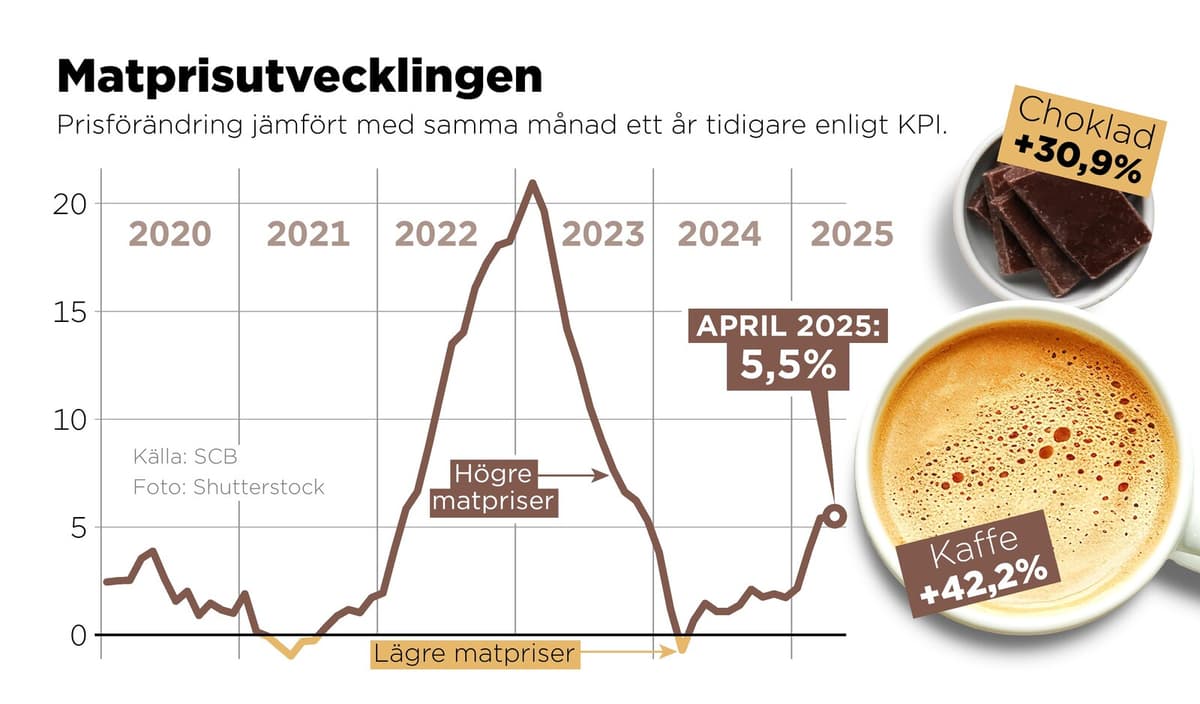Food prices, including non-alcoholic beverages, rose in April by 5.5 percent year-on-year, according to Statistics Sweden (SCB). The price increase has thus increased slightly. In March, it was 5.4 percent year-on-year.
Coffee prices rose unusually much in April. The black beverage has become 42 percent more expensive (plus 15 percent compared to March). Chocolate, in turn, has risen by almost 31 percent in a year. Food products that have risen a bit extra are dairy products like milk, cheese, and eggs, 7.6 percent more expensive in a year, according to SCB.
Coffee driving
Compared to March, food prices, including non-alcoholic beverages, rose by 0.2 percent.
It's a very small increase compared to the previous month, just 0.2 percent. So, it's almost unchanged food prices. Moreover, it's exclusively driven by coffee prices, which rose a lot on a monthly basis, says Nordea's chief analyst Torbjörn Isaksson.
It's not a broad increase for food prices, but rather it seems to have calmed down. Food prices have leveled out, he continues.
He also believes that coffee prices have peaked now.
Finance Minister Elisabeth Svantesson says she is closely following food prices.
They are partly affected by harvests, but also by other things. I think it's ominous if food prices were to continue to rise, she says.
Will we have to count on coffee being this expensive now?
I have limited expertise on coffee harvests, but we'll have to count on things happening in the world that affect food prices here as well.
Cheaper fish
But there are also food products that have become cheaper. Fish has decreased by 2.3 percent in price over the year. Interest rates and fuel costs have decreased by over 20 and nearly 17 percent, respectively.
Rents in rental apartments have risen by 5.5 percent in a year.
According to the measure KPIF, adjusted for interest rates and what the Swedish Central Bank uses, the overall inflation rate was 2.3 percent, the same as the preliminary figure showed last week.
Believe in interest rate cut
Jens Magnusson, chief economist at SEB, says that today's figures confirm the picture of a positive development regarding inflation, which increases the belief that the Swedish Central Bank will lower the interest rate at the next meeting.
If you also add that we saw an opening from the Swedish Central Bank at the last meeting for possible easing of monetary policy, we'll keep the view that it might come to a cut in June, he says.
Last week, Matpriskollen released the price development of food, which showed increased prices with 0.4 percent compared to March and plus 4.0 percent in a year.
This is how the measurement methods differ between SCB and Matpriskollen:
SCB measures actual sales and actual prices, and is based on a specific basket of goods where various goods "weigh" differently depending on how much of a particular good people buy.
The distribution of commodity groups in the basket for 2025 is determined based on consumer purchasing patterns in 2023 (most recently completed full year) and the specific goods in the selection are chosen based on data for both 2023 and 2024.
Matpriskollen is based on advertised regular prices of over 40,000 goods from the larger chains. Matpriskollen thus measures prices, not actual sales.
Sources: SCB and Matpriskollen





